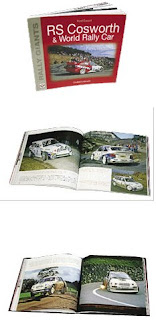 In his ‘Rally Giants’ series, Graham Robson aims to describe the shift in motor sport from reliability trials to the modern idea of road rallying. Today’s rally vehicles are engineered and driven with a focus on speed and strength first, and reliability second. They are high performance machines - with road-going homologation specials built pretty much as an afterthought to comply with regulations - not existing road cars tuned to stay the distance. Events are composed of a series of shorter intense races on closed road special stages instead of one long distance to endure over public roads.
In his ‘Rally Giants’ series, Graham Robson aims to describe the shift in motor sport from reliability trials to the modern idea of road rallying. Today’s rally vehicles are engineered and driven with a focus on speed and strength first, and reliability second. They are high performance machines - with road-going homologation specials built pretty much as an afterthought to comply with regulations - not existing road cars tuned to stay the distance. Events are composed of a series of shorter intense races on closed road special stages instead of one long distance to endure over public roads.Robson’s series approaches these changes through the development and competition histories of milestone vehicles, like the Ford Escort RS Cosworth in this book. By the late 1980s, Ford Motorsport (FM) was faced with the erosion of Ford’s competition status since the 1970s, an era dominated by the successes of the Escort Mk1 and 2. The RS200 had been too little, too late to stop the slide against Audi, Toyota, Subaru and Mitsubishi, Fiat, Peugeot and Lancia. The Sierra had looked promising but was too bulky and heavy to continue as it was.
It was critical that the new Cosworth succeed. Not only had Ford been the only British make consistently at the top level of world motor spot but it had also consistently made its technology and developments available to private buyers. This fact brings Robson to point out why new rally and race cars are important at all. The release of their homologation models affects car buyers’ expectations and thus, other manufacturers. Customers learn quickly what is possible from one year to the next, and expect to be able to buy it.
For example, once 4 wheel drive was accepted in rally cars after the Audi Quattro’s precedent, it was adopted for the Sierra Cosworth and refined in the lighter, nimbler RS to create the rallying breakthrough Ford needed. Car showrooms consequently began to reflect these changes.
Stuart Turner, director of FM at the outset of the project, and his team had all agreed that their next rally car had to be based on an existing mainstream model. “Why don’t we see if we can take the platform and running gear from a Sierra Cosworth 4x4, shorten it, then see if an Escort body will fit on it?” This line of development was more or less followed. The RS was 4½ years in the making, under four different directors, but it was worth it. In 1993, its first year, it won five World Championship rallies.
Readers will gain insight into Ford’s engineering methods and enjoy reading about the Ford Motorsport design team’s dynamics – the members really did work together. As one person’s idea was pursued, problems naturally emerged which other members would solve. Later chapters in the book explain the need to develop a World Rally Car, and the changes required to turn the Cosworth into that car.
 Photo buffs will relish the colour images in the ‘Rally Years’ section taken on location across Europe, Africa and Asia - wherever the RS was competing. Personally, I liked reading the collection of biographies of engineers, rally drivers and other influential people in the Cosworth’s development. Among many team drivers taking the RS Cosworth to victory, Carlos Sainz was a standout, driving during 1996, a top year for the RS. An early driver worth getting to know was Francois Delacourt, and dashing, talented Ari Vatanen is regarded as a true enthusiast’s hero.
Photo buffs will relish the colour images in the ‘Rally Years’ section taken on location across Europe, Africa and Asia - wherever the RS was competing. Personally, I liked reading the collection of biographies of engineers, rally drivers and other influential people in the Cosworth’s development. Among many team drivers taking the RS Cosworth to victory, Carlos Sainz was a standout, driving during 1996, a top year for the RS. An early driver worth getting to know was Francois Delacourt, and dashing, talented Ari Vatanen is regarded as a true enthusiast’s hero.Click HERE for more info about the book!





No comments :
Post a Comment